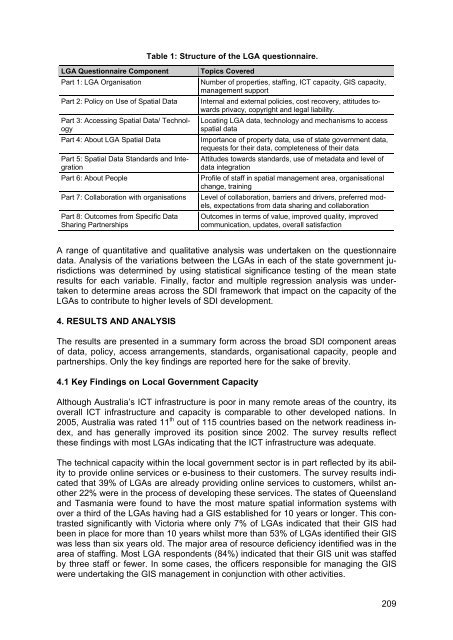SDI Convergence - Nederlandse Commissie voor Geodesie - KNAW
SDI Convergence - Nederlandse Commissie voor Geodesie - KNAW
SDI Convergence - Nederlandse Commissie voor Geodesie - KNAW
You also want an ePaper? Increase the reach of your titles
YUMPU automatically turns print PDFs into web optimized ePapers that Google loves.
Table 1: Structure of the LGA questionnaire.<br />
LGA Questionnaire Component Topics Covered<br />
Part 1: LGA Organisation Number of properties, staffing, ICT capacity, GIS capacity,<br />
management support<br />
Part 2: Policy on Use of Spatial Data Internal and external policies, cost recovery, attitudes towards<br />
privacy, copyright and legal liability.<br />
Part 3: Accessing Spatial Data/ Technology<br />
Locating LGA data, technology and mechanisms to access<br />
spatial data<br />
Part 4: About LGA Spatial Data Importance of property data, use of state government data,<br />
requests for their data, completeness of their data<br />
Part 5: Spatial Data Standards and Integration<br />
Attitudes towards standards, use of metadata and level of<br />
data integration<br />
Part 6: About People Profile of staff in spatial management area, organisational<br />
change, training<br />
Part 7: Collaboration with organisations Level of collaboration, barriers and drivers, preferred models,<br />
expectations from data sharing and collaboration<br />
Part 8: Outcomes from Specific Data<br />
Sharing Partnerships<br />
Outcomes in terms of value, improved quality, improved<br />
communication, updates, overall satisfaction<br />
A range of quantitative and qualitative analysis was undertaken on the questionnaire<br />
data. Analysis of the variations between the LGAs in each of the state government jurisdictions<br />
was determined by using statistical significance testing of the mean state<br />
results for each variable. Finally, factor and multiple regression analysis was undertaken<br />
to determine areas across the <strong>SDI</strong> framework that impact on the capacity of the<br />
LGAs to contribute to higher levels of <strong>SDI</strong> development.<br />
4. RESULTS AND ANALYSIS<br />
The results are presented in a summary form across the broad <strong>SDI</strong> component areas<br />
of data, policy, access arrangements, standards, organisational capacity, people and<br />
partnerships. Only the key findings are reported here for the sake of brevity.<br />
4.1 Key Findings on Local Government Capacity<br />
Although Australia’s ICT infrastructure is poor in many remote areas of the country, its<br />
overall ICT infrastructure and capacity is comparable to other developed nations. In<br />
2005, Australia was rated 11 th out of 115 countries based on the network readiness index,<br />
and has generally improved its position since 2002. The survey results reflect<br />
these findings with most LGAs indicating that the ICT infrastructure was adequate.<br />
The technical capacity within the local government sector is in part reflected by its ability<br />
to provide online services or e-business to their customers. The survey results indicated<br />
that 39% of LGAs are already providing online services to customers, whilst another<br />
22% were in the process of developing these services. The states of Queensland<br />
and Tasmania were found to have the most mature spatial information systems with<br />
over a third of the LGAs having had a GIS established for 10 years or longer. This contrasted<br />
significantly with Victoria where only 7% of LGAs indicated that their GIS had<br />
been in place for more than 10 years whilst more than 53% of LGAs identified their GIS<br />
was less than six years old. The major area of resource deficiency identified was in the<br />
area of staffing. Most LGA respondents (84%) indicated that their GIS unit was staffed<br />
by three staff or fewer. In some cases, the officers responsible for managing the GIS<br />
were undertaking the GIS management in conjunction with other activities.<br />
209

















